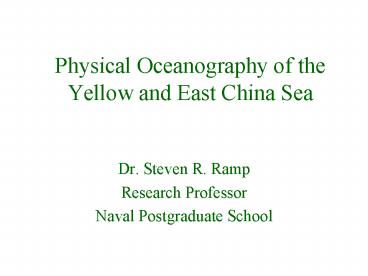Physical Oceanography of the Yellow and East China Sea - PowerPoint PPT Presentation
1 / 19
Title:
Physical Oceanography of the Yellow and East China Sea
Description:
Physical Oceanography of the Yellow and East China Sea. Dr. Steven R. Ramp. Research Professor ... Mean surface currents in the ECS, averaged from 31 years of ... – PowerPoint PPT presentation
Number of Views:65
Avg rating:3.0/5.0
Title: Physical Oceanography of the Yellow and East China Sea
1
Physical Oceanography of the Yellow and East
China Sea
- Dr. Steven R. Ramp
- Research Professor
- Naval Postgraduate School
2
Bottom Topography of the East China Sea. The
proposed ASIAEX study region is indicated
3
General Circulation of the Yellow and East China
Sea
from Chen et al., 1986
4
Mean surface currents in the ECS, averaged from
31 years of GEK data. from Qiu and Imasato, 1990
5
Bi-Modal Structure of the Kuroshio Exiting the ECS
Northern Position
Southern Position
from Feng et al., 2000
6
Velocity and Potential Vorticity Cross-Sections
From the Kuroshio Near the ASIAEX Study Region
Alongshore Velocity
Potential Vorticity
7
Temperature
Salinity
Surface
Yellow Sea T/S Characteristics Winter
Bottom
8
Salinity
Temperature
Surface
Yellow Sea T/S Characteristics Summer
Bottom
9
M2 (semidiurnal) Tidal Ellipses in the Yellow and
East China Sea from Larsen et al., 1985
10
Residual Tidal Currents in the Yellow Sea from
the Lee and Beardsley (1999) stratified
model. These currents result from the
rectification of tidal currents by topography.
11
Surface Temperature Fronts in the Yellow and East
China Sea from Hickox et al., 2000
12
East China Sea ASIAEX Site Locator Map
Mooring Site
CTD Transect
13
Across-Shelf Temperature and Salinity
Sections From the ASIAEX Pilot Study Cruise,
April 2000
Temperature
Salinity
14
Along and Across-Shore ADCP Velocity
Sections ASIAEX Pilot Study Cruise, April 2000
15
Alongshore (red) and Across-shore (blue) velocity
components from the ASIAEX mooring, ECS Shelf
16
Expanded x-axis to show internal solitary waves
17
Expanded Even more..
18
Soliton Distributions in the Central Yellow Sea
From Hsu et al., 2000
19
Receive Arrays WHOI/NPS/PRC
Oceanographic Moorings
400 Hz Source WHOI/NPS
LOCO Moorings
Tomo Moorings Japan
ECS Volume Interaction Sampling Plan
SEASOAR track
J-15 Source Track
Kuroshio Edge































